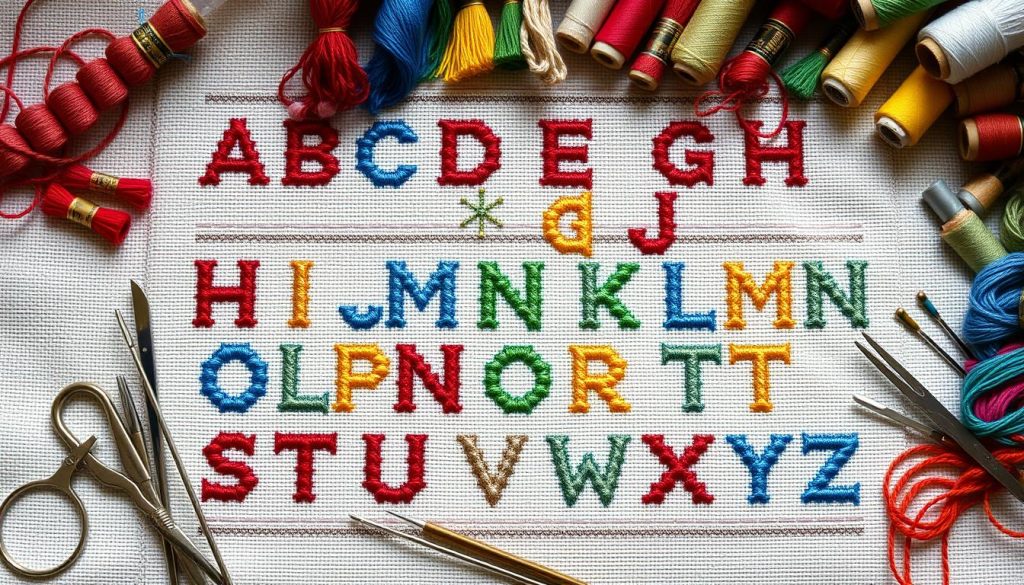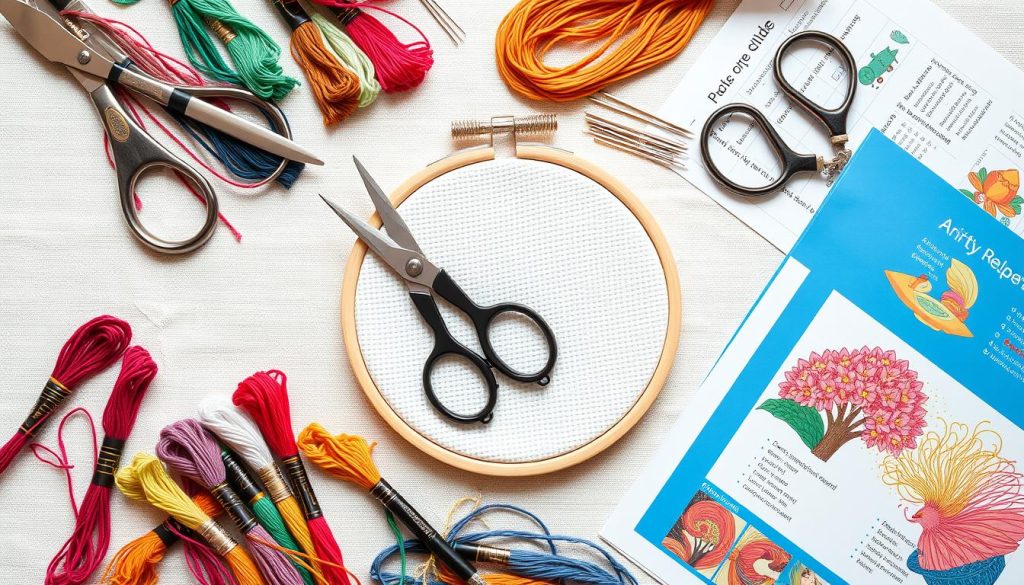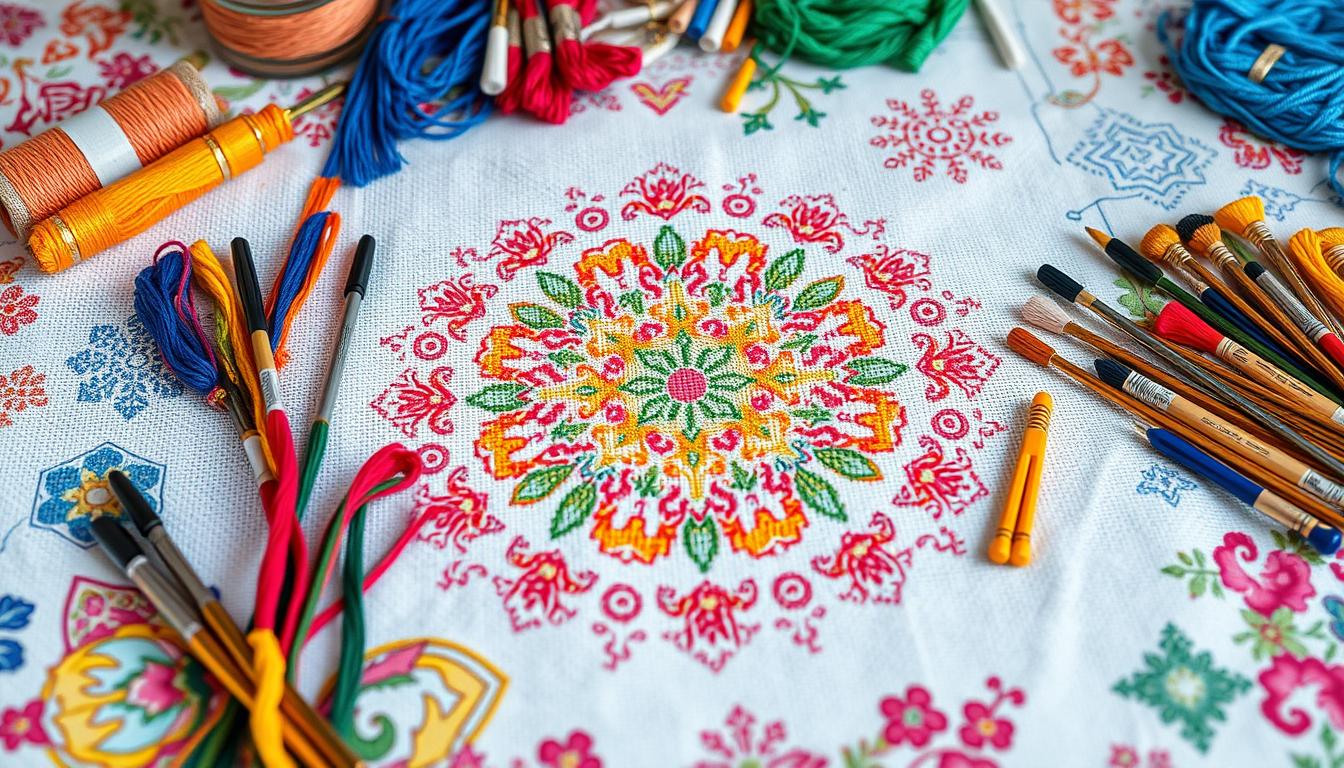Starting your cross-stitch project in the middle can make a big difference. It helps keep your design centered, which is key for a balanced look. This approach also avoids the problem of running out of fabric, a common issue when starting from a corner.
Whether you’re doing a DIY project or following a pattern, starting in the middle is helpful. It gives you a clear starting point, leading to a better finish.
Key Takeaways
- Starting in the middle helps keep cross-stitch patterns centered.
- This method minimizes the risk of running out of fabric.
- It allows for a more balanced and professional finish in cross-stitch designs.
- Middle-starting is beneficial for both DIY cross-stitch projects and pre-designed kits.
- It simplifies the cross-stitching process by providing a structured starting point.
Introduction to Cross Stitch
Cross stitch is a popular embroidery style known for its X-shaped stitches. It uses a needle and thread to create designs on fabric. If you’re new to crossstitching, learning the basics is key.
What is Cross Stitch?
Each stitch in cross stitch looks like a small “X.” The fabric often used is Aida or linen, which can fray. Embroidery floss has six strands, but usually, only one or two are used at a time.
For beginners, free crossstitching patterns are great for practice. They help you improve your skills. It’s also good to start stitching near the fabric’s middle for a centered design.
The History of Cross Stitch
Cross stitch has a long history, dating back to ancient times. It was used for decorative mending in Asia and Europe. Over time, it became a popular art form in the Middle Ages.
Today, crossstitching is loved worldwide for its creativity and relaxation. You can find free patterns online to explore this craft. Learning about cross stitch history adds to its beauty and cultural value.
The Benefits of Starting in the Middle
Starting your cross-stitch project from the center has many benefits. It makes your work better and faster. This method is great for making detailed crossstitching home decor or special cross stitch gifts.
Ensuring Centered Designs
Starting from the middle ensures your design is perfectly centered. This is key for symmetrical results. With charts as large as 380w x 253h, finding the center is crucial.
Minimizing Fabric Distortion
Starting in the center reduces fabric distortion. Starting from the sides or corners can cause unevenness. Using a scroll frame or hoop stand helps, but starting from the center is best.
This method keeps your fabric’s shape and integrity.
Efficient Use of Fabric and Threads
Starting from the center is an efficient way to use fabric and threads. It helps avoid wasting materials, which is key for big or complex designs. Using fabric and threads wisely means you won’t run out in the middle of your project.
This is crucial for detailed crossstitching gifts or elaborate home decor.
| Fabric Type | Grid Marking | Count |
|---|---|---|
| Magic Guide Fabric | 10 x 10 squares for 14 to 18 count | 20 x 20 squares for 25 count and above |
| Easy Count Fabric | 10 x 10 grid for all fabric counts | N/A |
How to Find the Center of Your Fabric
Finding the center of your fabric is key in crossstitching. It makes sure your design is balanced. Learning this skill can make your stitching better.
Folding Techniques for Finding the Center
Folding is a simple way to find the center. Just follow these steps:
- Fold the fabric in half vertically, aligning the edges carefully.
- Fold the fabric again in half horizontally.
- Press lightly at the intersection of the folds to create a crease. This crease marks the center of your fabric.
These steps are easy and ensure you start right.
Using Markers and Pins
Markers and pins can also help find the center:
- After folding, use washable fabric markers to mark the crease.
- Or, place a pin through the fabric at the crease. This makes a precise mark.
- When stitching, remove the pin or rub off the marker. This leaves no marks.
- These tips are great for big projects where you need to be exact.
Both folding and using markers and pins are important in cross stitch. They help you make designs that look good. Using these techniques can prevent problems like designs that are off-center.
| Method | Steps | Advantages |
|---|---|---|
| Folding |
|
|
| Markers and Pins |
|
|
Getting Started with Your Cross Stitch Project
Starting your cross stitch journey is exciting and rewarding. It’s one of the simplest hand embroidery techniques to learn. You can choose from many designs, from classic to modern. To begin well, learn to read charts, pick the right fabric, and get your threads and needles ready.
Reading Cross Stitch Charts
Before you start stitching, get to know crossstitching charts. They guide you on where to stitch and what color to use. Each square on the chart matches a square on your fabric. Following the chart closely ensures your design looks perfect.
Selecting the Right Fabric
Picking the right fabric is key. Aida and linen are common choices, each with its own benefits. Aida is great for beginners because it’s easy to see. Linen is better for detailed designs and gives a finer finish. Choose a fabric that fits your chart’s complexity.
Preparing Your Threads and Needles
Getting your threads and needles ready is important. Embroidery floss usually has six strands, but you’ll often use just one or two. A good trick is to measure thread length from your fingertips to your elbow. This prevents knots and keeps the thread manageable.

Also, make sure to tie the thread right to keep tension even. This prevents your stitches from warping or becoming uneven. A well-set-up cross stitch area makes stitching smooth and enjoyable.
| Aspect | Recommendation |
|---|---|
| Charts | Follow the cross stitch charts to guide color placement and stitching areas. |
| Fabric | Select between Aida for beginners or linen for more intricate designs. |
| Threads | Separate 2 strands from the 6 unless the pattern specifies otherwise. |
| Needles | Ensure cross stitch needles are suitable for the chosen fabric and threads. |
With these tips, your crossstitching project is ready to succeed. Starting in the middle helps keep your work centered. Happy stitching!
Cross Stitch Techniques for Beginners and Advanced Crafters
Starting out or looking to improve your advanced cross stitch skills? This section will cover key and detailed cross stitch techniques. Learning these will boost your crafting skills and make your projects look amazing and precise.
Beginners should start with 14 count Aida cloth, the top fabric for crossstitching. You’ll need two strands of embroidery floss, a thread length from elbow to fingertips, and a needle. Start with full cross stitches for beginners. Always use an embroidery hoop or frame to keep your fabric tight.
For those more experienced, try more complex designs like beading and metallic threads for sparkle. Joining crossstitching forums can offer great tips and cross stitch tutorials for new challenges. DMC embroidery floss is a top choice for its quality and color range, perfect for detailed color work.
“Evenweave fabric is best for cross stitch due to its even weaving and an equal number of threads in each direction.”
| Technique | Recommended For | Materials Needed |
|---|---|---|
| Basic Cross Stitch | Beginners | Aida cloth, embroidery floss, needle, hoop |
| Beading | Advanced | Beads, metallic threads, needle, evenweave fabric |
| Color Variations | Advanced | DMC embroidery floss, needle, evenweave fabric |
Getting involved in online communities and cross stitch forums can spark inspiration and support. It’s a chance to learn the latest cross stitch techniques. Push your limits with new patterns and materials through detailed cross stitch tutorials.
Tools and Supplies You’ll Need
Starting with cross stitching means you need the right tools and supplies. You’ll need embroidery hoops, threads, and other accessories. These items make your crafting better and help your projects last longer.
Embroidery Hoops and Frames
Keeping fabric tight is key for even stitches and avoiding fabric issues. Cross stitch hoops are vital for this. Wooden hoops are better than plastic ones because they grip better and look nicer. A 7-inch diameter hoop is good for beginners.
Q-Snaps are also great for keeping fabric tight. For bigger projects, scroll-frames help keep fabric tension even.
Thread Types: Cotton, Silk, and Wool
Choosing the right thread is crucial for cross stitch. Cotton threads from DMC and Anchor are popular for their versatility and color range. DMC floss is made from 100% Egyptian cotton and has many colors.
Silk threads add a luxurious look but cost more. Wool threads give a unique texture and are good for rustic designs.

Additional Accessories: Scissors, Magnifiers, and More
You’ll also need sharp scissors for cutting threads. Needle minders help prevent needle loss. Good lighting and magnifiers are key for detailed work to avoid eye strain.
Needle threaders make threading easier. Project bags and floss boards help keep things organized.
| Tool/Accessory | Description | Recommended Brands |
|---|---|---|
| Embroidery Hoops | Essential for fabric tension | DMC, Wooden Hoops |
| Threads | Available in Cotton, Silk, and Wool | DMC, Anchor |
| Needle Minders | Prevent needle loss | N/A |
| Magnifiers | For intricate work | N/A |
| Needle Threader | Simplifies threading | N/A |
| Scissors | For precise cutting | Gingher, Fiskars |
| Project Bags | Organizational tool with clear visibility | N/A |
| Floss Boards | Keeps threads organized | N/A |
Common Mistakes to Avoid
One big cross stitch challenge is avoiding common mistakes. These mistakes can ruin the look and quality of your project. Learning some cross stitch tips early can help you avoid these mistakes and fix any problems quickly.
Miscounting Stitches
Miscounting stitches is a common error that can mess up your pattern. Cross stitch patterns often give thread counts for fabric. This count tells you how many threads are in each square inch. If you use the wrong thread count, your project might be too big or too small.
To avoid mistakes:
- Make sure you use the right number of strands, usually 2 strands from the 6 in embroidery floss.
- Always start with the first stitch in the same direction to keep things even.
- Start your pattern in the center to avoid running out of space.
Inconsistent Tension
Keeping your stitches at the same tension is key for a neat look. If your tension is off, your fabric might bunch up or your stitches could be too loose. Here are some cross stitch tips to help:
- Don’t knot the thread in the back. It looks messy. Instead, hide the thread tail under the stitches or use a loop start.
- Wash your hands before stitching to keep oils and dirt off your project.
- Use a daylight lamp to reduce eye strain and make it easier to see what you’re doing.
- Make sure to oversew fabric edges before you start to prevent fraying.
- Don’t leave your project in an embroidery hoop when you’re not stitching. It can cause pulling issues.
Knowing these cross stitch challenges can make your work much better. By following these cross stitch tips, you can avoid mistakes and enjoy your stitching more.
Conclusion
Starting your cross stitch journey in the middle might seem odd, but it changes everything. It leads to designs that are more centered and cohesive. It also helps avoid fabric distortion and makes the most of fabric and threads.
This method is both structured and creative, making it rewarding for all. Beginners and experts find joy in it.
Getting into the cross stitch community is a big plus. It’s full of knowledge, resources, and support. Online and offline, there are endless tutorials, forums, and competitions to show off your skills.
Whether you start with a $5 kit or a Bohin needle pack, it’s easy to begin. The craft is affordable, making it accessible to everyone.
But cross stitch is more than just pretty pictures. It’s good for your mind and mood. The rhythmic motions can lower anxiety and boost your mood.
Stitching also improves patience, focus, and even helps with brain health. Your cross stitch is a sign of your creativity and mental well-being.
In summary, starting in the middle makes cross stitch more symmetrical and enjoyable. The community support and benefits make it a great hobby. It’s perfect for finding peace or making special keepsakes.
